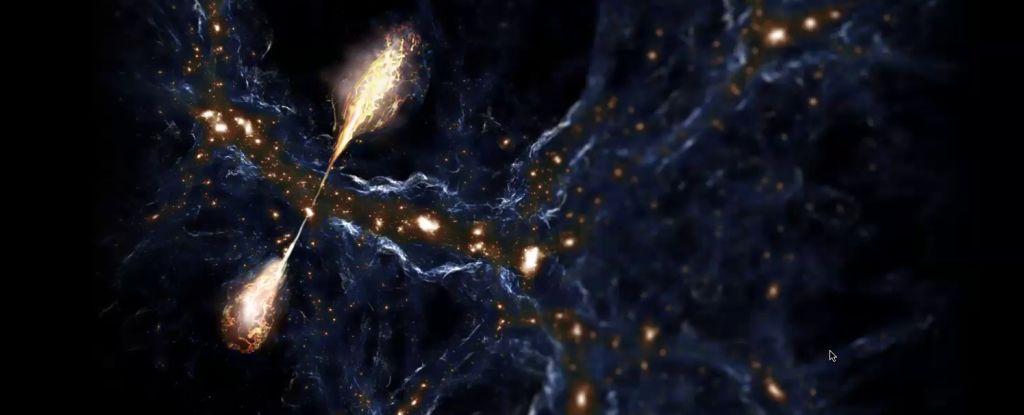A supermassive black hole blasting astrophysical jets into space has carved out the biggest structure of galactic origin we’ve ever seen.
It’s been named Porphyrion, after the king of giants in Greek mythology, and it spans, in total, some 7 megaparsecs across space-time. That’s a whopping 23 million light-years from end to end, making it a significant part of the cosmic web that connects the Universe.
“Porphyrion shows that small things and large things in the Universe are intimately connected. We are seeing a single black hole that produces a structure of a scale similar to that of cosmic filaments and voids,” astronomer Martijn Oei of Leiden University in the Netherlands and Caltech told ScienceAlert.
“If we shrink the jets to the size of the Earth and the black hole accordingly, the black hole would have the size of 0.2 millimeters: the size of an amoeba or a mite on your skin. So these giant jets are incredible: they are as if a single amoeba was able to generate a powerful fountain of energy the size of the entire Earth!”
It’s a marvelous discovery, and one that raises so many questions – because it’s not an anomaly. It follows on the heels of Alcyoneus, a galaxy with jets that span 16 million light-years. This means that the ingredients for generating ‘impossible’ black hole jets – so big that we thought they would not be able to exist – may actually be quite normal in the Universe.
Astrophysical jets that are created by black holes have formation mechanisms that we don’t understand very well.
We know that, when a black hole is feeding, some of the material from the inner rim of the disk that’s swirling around and falling onto the black hole gets diverted and accelerated along magnetic field lines to the poles, where it is launched into space as powerful jets of plasma and magnetic field, traveling at a significant percentage of the speed of light.
These jets are all over the Universe. Supermassive black holes go through bursts of feeding and growth, and jets are a natural consequence. But the jets of Alcyoneus and Porphyrion present several challenges.
The first is that, in order to generate such huge jets, the black hole needs to be feeding continuously – which implies a huge reservoir of material – for a period of about a billion years, and that’s not typical, although obviously it’s not impossible, because we’re looking at the results.
The other is the length of the jets. We’re peering back 7.5 billion years into the past to see Porphyrion, a time when intergalactic space was more dense than it is today. And the longer a jet grows, the more unstable it becomes. Once an instability is introduced, the jet should fall apart.
“Both pen-and-paper work and numerical simulations of jet physics suggest that jets are unstable structures: once disturbed, the disturbances tend to grow and not diminish,” Oei said.
“Eventually the jets are destroyed. So such (magneto)hydrodynamical instabilities together with the limited fueling time of the jets (which, though, can extend to billions of years!) probably sets a rough ‘upper limit’ to jet growth – even though we’re not sure where that limit is.”
How the jets of Alcyoneus and Porphyrion remained stable over such vast distances of space-time is a mystery.
But they could be giving us some clues about how the Universe is structured. Spanning across every epoch of space-time is a structure called the cosmic web – a huge system of filaments, consisting of dark matter that gravitationally corrals galaxies; the hubs of galaxy clusters where these filaments meet; and the huge voids between the filaments.
The length of Porphyrion’s jets, according to the team’s calculations, is about 66 percent of the radius of the void within which Porphyrion sat at that point in time.
This suggests that these mega-jets could be playing a role in shaping the cosmic web. They could, the researchers say, be responsible for the strangely high temperatures detected in voids, and the magnetic field structures found therein. These features could have been placed there by the jets.
This is especially interesting, because the black hole is of a kind seen quite often in the early Universe – a radiative mode active black hole, one that is generating a lot of radiation. This could mean that there were a lot more huge jets in the early Universe than we realize, playing a significant role in sculpting the cosmic web.
Even later, the research team believes, the cosmos could be teeming with such galaxies.
“I think galaxies with giant jets are more common than we realize,” Oei said.
“That is because giant jet systems become harder to observe when they grow larger. They’re also harder to observe in the more distant Universe. So the number of giant jets detected at the moment is limited by our instrumental capabilities. Once the instruments improve in the coming few years, I expect that many more galaxies with giant jets will be found.”
And with them, hopefully, some answers to these puzzling, beautiful questions.
The team’s research has been published in Nature.





